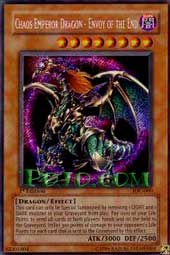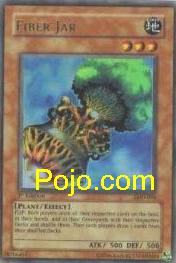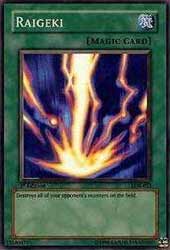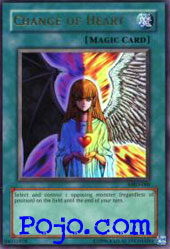|
|
|||||
| Pojo's Yu-Gi-Oh! news, tips, strategies and more! | |||||
|
|
|||||
 |
|||||
|
Card Game Featured Writers Releases + Spoilers Anime Video Games Other
-
Magic
This Space |
napay's Daddio Dueling Den In Part C I looked at the 13 cards that were in both the 2003 and 2004 World Championship winner’s decks that are primarily used to strengthen your position. The analysis was done by placing the cards on a Star Circle to indicate where the impact of the card was targeted, meaning just exactly where was the benefit received. In Part 4 I want to look at 14 more cards from the championship decks (7 from 2003 and 7 from 2004). I see recurring posts on the Pojo Message boards about replacing cards. Stuff like: Lightning Vortex replaces Raigeki, Summoner of Illusions replaces Magical Scientist and Fenrir replaces Yata. There are almost always two sides to these message threads; one group of folks generally feel that you need to replace cards in your deck when one gets banned and/or a better one comes along and another group of folks generally feel like bans are crafted to shift the game into new directions, therefore replacing cards to retain a deck style is like sticking around to eat the crumbs after the cheese has been moved away (if you don’t get it, read “Who Moved My Cheese” next time you’re in a bookstore buying the next Pojo Book, it’s a very fast read that can change your life). This article is focused on the first argument that cards can be replaced. For today’s analysis I’ve studied the cards that did not repeat from 2003 in the 2004 winning deck. Then, I Star Circled the cards based on where the benefit or pain would be applied and starting looking for pairings. I was able to identify 7 of them. You may not agree with them but that’s ok. I’m more interested in sharing the method of analysis than the results. You can take this analysis and apply it to lots of other things. So here are the cards:
Gemini Elf Replaced in 2004 with:
Berserk Gorilla Let’s look at Gemini Elf replaced with Berserk Gorilla first. Is it as simple as 1900 beatstick replaced with 2000 beatstick? I think so. Generally it’s good to have cards that give you options. I think Berserk Gorilla is an exception. I’ve posted recently on the message boards in search of a way to exploit Berserk Gorilla’s “must attack” effect against my opponent. I’ve not found a really good one. Reason being, if things get too hot your opponent can manually change Berserk Gorilla to DEF position and it’s destroyed, problem gone. You can now get a number of 1900 ATK normal monsters like Insect Knight and Archfiend Soldier. But Berserk Gorilla has its own place and its effect is not too problematic for its user. By the way, I placed these two cards on my top Star Circle point, the one that represents my field because the primary use of these monsters is for attacking my opponent and maintaining field presence.
Now we look at two banned cards, Fiber Jar which was Is D.D. Warrior Lady (DDWL) better than Exiled Force? Well, let’s see. Both of them weaken your opponent’s field position. In 2004 Exiled Force was restricted to 1 and DDWL was being run in 3’s. Exiled is an earth attribute while DDWL is light. Oh, but wait, DDWL removes itself from play so it’s not really very good chaos food. Another advantage Exiled Force has over DDWL is that Exiled doesn’t have to attack to get the benefit of its effect. Attacking presents your opponent with the option of responding. So using DDWL puts you at risk of running into your opponent’s Magic Cylinder or Mirror Force. When you activate Exiled you don’t run these risks. Now that DDWL is restricted to one, I’m going to say Exiled Force is better, but look for DDWL to maybe get semi-limited in the future (no, I don’t have any inside info on this – I’m just speculating publicly). Of course, there is no exclusivity about this, a lot of players run both.
Here’s another pairing that really weakens I will admit that Harpie’s Feather Duster (HFD) and Breaker the Magical Warrior might not be the best pairing for this analysis. However, it’s very clear that HFD was an overly powerful card that just begged to be banned. Pounding the spell and trap cards on your opponent’s field is a bit tougher to do now. You need to pick at it, one card at a time, one effect at a time if you want to keep your opponent’s spell and trap zone clean. So when you look at what’s out there Breaker the Magical Warrior isn’t so bad, it’s actually pretty good. In Yu-Gi-Oh flexibility is a valuable commodity. With all the 1900 ATK normal monsters (the yellow ones) running around, here’s a 1900 ATK that gives you the option to reduce it’s ATK by 300 points so you can wipe out a spell or trap. Here’s another way to say this, with a lot of cards you need to get two cards to do one thing (I’m talking combos like MST and Mirage of Nightmare), but here’s a card that gives you two things you can do with one card. I like that because you can adjust what you do to the immediate needs you have.
It’s absolutely priceless to take your opponent’s The last pairing is Drop Off and Time Seal, which is better? At first they appear to do the same thing in denying your opponent the draw of the card that’s on top of their deck. But there’s more. Time Seal prevents the entire draw phase from happening, while Drop Off allows the Draw Phase, but makes your opponent dump the card in their graveyard. So the difference is that with Drop Off they still win if they draw the last piece of Exodia. But more importantly, if they draw a Quickplay spell card and start a chain following Drop Off, then they get to play the Quickplay and you’ve wasted Drop Off. Imagine they draw MST and wipe out your Call of the Haunted or Premature Burial. You’ve lost two and they lose one; think about it. I also think a card in the graveyard is more valuable than a card that is shuffled in your deck. When it’s in the graveyard you know exactly where it is. So, I think Drop Off actually improves the position of the card because it is effectively sent to the graveyard from the deck. Once in the graveyard the card can be recovered by a variety of means if needed. While both of these cards are great for weakening your opponent’s hand, I think Time Seal is better. My first overall observation about these cards is that nothing is free anymore. Raigeki, Harpie’s Feather Duster, Change of Heart and Fiber Jar were all no-cost killer cards. Now you got to invest effort, discards, life points and field presence to get stuff accomplished; there’s no free cheese. Furthermore, cards like Creature Swap and Tribe-Infecting Virus require you to use a good bit of skill if you want to maximize the benefit you get while weakening your opponent as much as possible. I think this is a very good thing, because it forces players to improve their play and be more cognizant about timing. Timing is one of the hidden factors that greatly affects the outcomes of duels. It’s not just about attack and effects, it very much about when you declare the attack and when you set off the effects. Another observation is that we don’t often consider the value of having cards that create options for us. Cards that have multiple benefits offer flexibility in your hand and on the field. We all know that having more cards in your hand is good because it gives you more options, but it’s also good to have cards that give you options in their use. It’s also clear that the more you can reduce the options your opponent has the better. Winning at Yu-Gi-Oh is very much about restricting your opponent’s ability to make strategic choices. The original idea was to see if replacing cards is a good idea. Clearly, it’s great to replace a card when a better one comes along like Berserk Gorilla or Time Seal. In the case of “field nuking” cards, there is no real replacement and we’re all going to have to move on to something different. Then there’s the remaining question, is it good to replace a banned card with a card that carries some negatives or is less powerful? I think there is no clear answer to this and I’ll explain why in my next article. Please feel free to e-mail me thoughts about these cards or the other cards that I’ve not discussed in prior parts of this series. Maybe I’ll include your thoughts in the next article. notasperfectasyou It’s easy to find me on the message board, e-mail is ok, but I like open discussion better. napay’s prior articles and why you’d want to read them: “Thoughts and Observations about Winning Decks – Part C” presents a third installment of analysis for the purpose of seeing what can be learned from comparing two proven decks focusing on cards that strengthen your position. “Thoughts and Observations about Winning Decks – Part B” presents a second installment of analysis for the purpose of seeing what can be learned from comparing two proven decks focusing on cards that weaken your opponent. “Thoughts and Observations about Winning Decks – Part A” presents a first installment of deck analysis for the purpose of seeing what can be learned from comparing two proven decks. “Mom and Dad Won’t Let Me Buy Cards On EBAY” presents some thoughts on the good and the bad of buying cards on EBAY and how you might work EBAY for a better experience. “The Exodia FTK” presents an example of applying calculated mathematical probabilities to Yu-Gi-Oh in demonstration of why a deck 40 cards is a good idea. “Fake/counterfeit Yu-Gi-Oh cards” presents a summarized version of my own experience buying fake cards and what I learned from it. “The Star Circle” presents a very visual way to think about the components of your deck and how to think about card flow as a way to improving your deck. “How Big is your Monster” is about why you need to stop thinking about how to get big ATK monsters in your deck and why you do need to think about how cards work synergistically.
|
||||
|
Copyrightę 1998-2005 pojo.com This site is not sponsored, endorsed, or otherwise affiliated with any of the companies or products featured on this site. This is not an Official Site. |
|||||


 2003
Cards:
2003
Cards: replaced with Chaos Emperor Dragon – Envoy of the End (CED).
Both cards clear the field and then it’s still your
turn. You get to time when you use them so I identify
them with weakening my opponent’s field. Both cards are
banned for good reason; playing CED has been likened to
“nuking” the field. I suppose in today’s environment
this deck slot has been filled with Black Luster Solider
– Envoy of the Beginning (BLS), however BLS is not a
field “nuking” card in the way Fiber Jar and CED are.
It is true that there are other field nukes, but they
are way harder to use and end up being very unreliable.
If you want to follow up on this idea anyway, check out
Mega Ton Magical Cannon, Huge Revolution and Ojama Delta
Hurricane.
replaced with Chaos Emperor Dragon – Envoy of the End (CED).
Both cards clear the field and then it’s still your
turn. You get to time when you use them so I identify
them with weakening my opponent’s field. Both cards are
banned for good reason; playing CED has been likened to
“nuking” the field. I suppose in today’s environment
this deck slot has been filled with Black Luster Solider
– Envoy of the Beginning (BLS), however BLS is not a
field “nuking” card in the way Fiber Jar and CED are.
It is true that there are other field nukes, but they
are way harder to use and end up being very unreliable.
If you want to follow up on this idea anyway, check out
Mega Ton Magical Cannon, Huge Revolution and Ojama Delta
Hurricane. your opponent’s field position. We all know that
Tribe-Infecting Virus (TIV) is not Raigeki. But,
Raigeki is banned and TIV is not. Now everyone is
chasing down Lightning Vortex which requires a one card
discard just like TIV. But you can only use Lightning
Vortex once, after that it’s in your graveyard. TIV can
be reused so long as it stays on the field, so if you
have Sinister Serpent and a well protected TIV, you get
to go hunting every turn. Even without Sinister
Serpent, you just might want to use the effect twice in
one turn so you can clear more monsters. TIV has a 1600
ATK which isn’t shabby either. I like TIV, but I bet
you’re going to see this slot filled with Lightning
Vortex in the near future. Then again, they’re both on
the restricted list, so maybe folks will run both.
your opponent’s field position. We all know that
Tribe-Infecting Virus (TIV) is not Raigeki. But,
Raigeki is banned and TIV is not. Now everyone is
chasing down Lightning Vortex which requires a one card
discard just like TIV. But you can only use Lightning
Vortex once, after that it’s in your graveyard. TIV can
be reused so long as it stays on the field, so if you
have Sinister Serpent and a well protected TIV, you get
to go hunting every turn. Even without Sinister
Serpent, you just might want to use the effect twice in
one turn so you can clear more monsters. TIV has a 1600
ATK which isn’t shabby either. I like TIV, but I bet
you’re going to see this slot filled with Lightning
Vortex in the near future. Then again, they’re both on
the restricted list, so maybe folks will run both. monster and beat them up with it. Just look at it on a
pair of Star Circles. When you really think about it,
your opponent did a good bit of work to get that monster
on the field for you to take. Change of Heart was just
too easy to use so it got banned. Then Creature Swap
showed up. Sure it’s more balanced and you lose a
monster, but you get to decide when you play it and you
get to set up the monster you’re giving away in the most
disadvantageous position for your opponent. A lot of
folks also forget that the exchange doesn’t revert back
at the end of the turn, so plan accordingly. One good
strategy is to play Creature Swap immediately after
you’ve used a flip effect. Give them an attack position
Magician of Faith. You also want to make sure that
there isn’t much of a selection on your opponent’s
side. Ideally they have only one monster so they don’t
have any options and it’s a good one that you’d want to
have. As noted above, it’s great to have options;
likewise, it’s bad for your opponent when you restrict
their options.
monster and beat them up with it. Just look at it on a
pair of Star Circles. When you really think about it,
your opponent did a good bit of work to get that monster
on the field for you to take. Change of Heart was just
too easy to use so it got banned. Then Creature Swap
showed up. Sure it’s more balanced and you lose a
monster, but you get to decide when you play it and you
get to set up the monster you’re giving away in the most
disadvantageous position for your opponent. A lot of
folks also forget that the exchange doesn’t revert back
at the end of the turn, so plan accordingly. One good
strategy is to play Creature Swap immediately after
you’ve used a flip effect. Give them an attack position
Magician of Faith. You also want to make sure that
there isn’t much of a selection on your opponent’s
side. Ideally they have only one monster so they don’t
have any options and it’s a good one that you’d want to
have. As noted above, it’s great to have options;
likewise, it’s bad for your opponent when you restrict
their options.